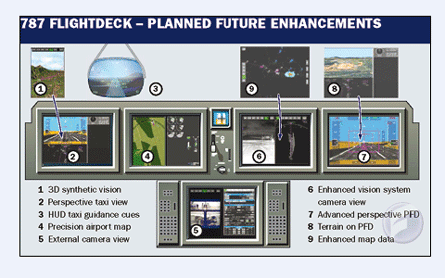Airbus and Boeing are providing glimpses of the potential for flightdeck development beyond the initial equipage for their new competing widebodies, respectively the A350 and the 787.
In both cases the manufacturers emphasise that continuing advances in avionic systems integration will not only provide significant improvements in pilot situational awareness, but that the system architecture makes updates and new capabilities easier to introduce.
Boeing is providing 787 customers with a view of its flightdeck not just as an initial product but also as "a foundation for future enhancements".
At its introduction the 787 will have - as standard - many features, like head-up displays and a class 3 electronic flight bag that on previous types were options, but for the future it promises features like 3D synthetic vision or perspective taxi view combined with the primary flight display (PFD).
 |
|---|
The PFD itself will provide a full-screen 3D-like perspective rather than a graphic display of attitude, and it will offer pilots the ability to select pictures of local terrain that may not be visible because of darkness or cloud.
The 787's flightdeck architecture, says Boeing, will consist of only 12 line replaceable units (LRUs) compared with the 777's 22.
Integrated approach navigation will allow pilots to combine position information from all sources and use the same techniques for flying approaches that they would normally use today for an instrument landing system approach, even if the decision heights differ.
Meanwhile, Airbus, with the A350's service entry five years behind the 787's May 2008 debut with All Nippon Airways, is planning the avionic system architecture behind the displays to allow it to accommodate all the capabilities pilots will expect by 2013, plus the flexibility and capacity to upload new software and to combine data from multiple sources and sensors for flight management and aircraft systems control.
Airbus says it will further develop the integrated modular avionics (IMA) concept developed for the A380, but whereas the A380's IMA manages 23 functions for avionics, landing gear, fuel, brakes and pneumatics, in the A350 it will manage up to 40 functions, including "new ones such as the oxygen system, full cabin pressurisation system and fire detection".
The benefits, promises Airbus, will be reduced maintenance and less weight. The manufacturer says the A350's IMA will replace multiple separate processors and LRUs with around 50% fewer standard computer modules known as line replaceable modules.
The IMA runs on a 100 Mbit/s network based on the avionics full-duplex (AFDX) standard, already employed in the A380 instead of the Arinc 429 system on the A330 and A340.
AFDX is based on aviation-adapted ethernet technology, Airbus explains, and its advantage is that the communications between functions do not rely on hard-wiring between LRUs, but work automatically over a centralised network.
Also this architecture can support new functions "with little or no physical implication", says Airbus.
As for the A350 flightdeck appearance, Airbus says: "We'll probably have slightly larger information displays at the side, but otherwise it is very much an A380 cockpit."
Related content
- Dreamliner timeline
- 787 - the gamechanger
- Qatar frustrated by lack of A350 technical detail
- Kingfisher swoops with A350 orders
Source: FlightGlobal.com



















